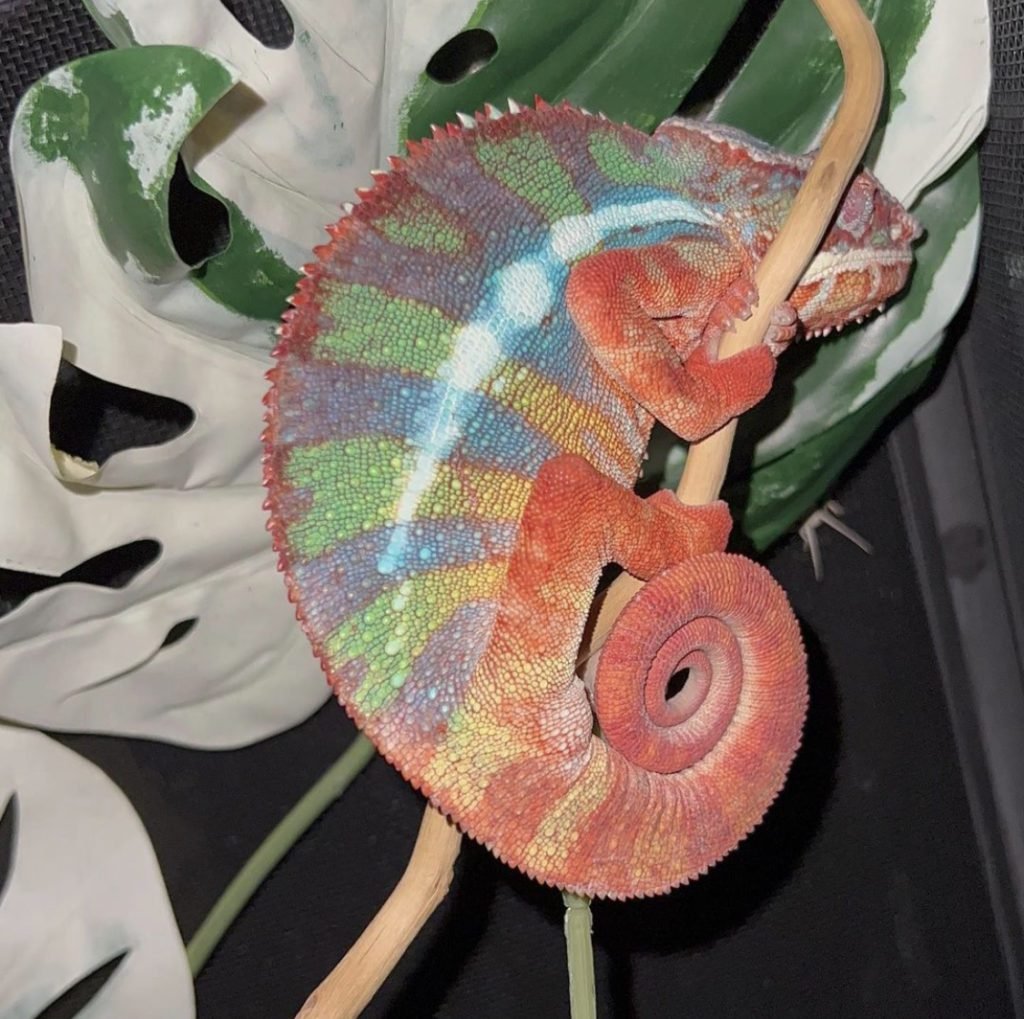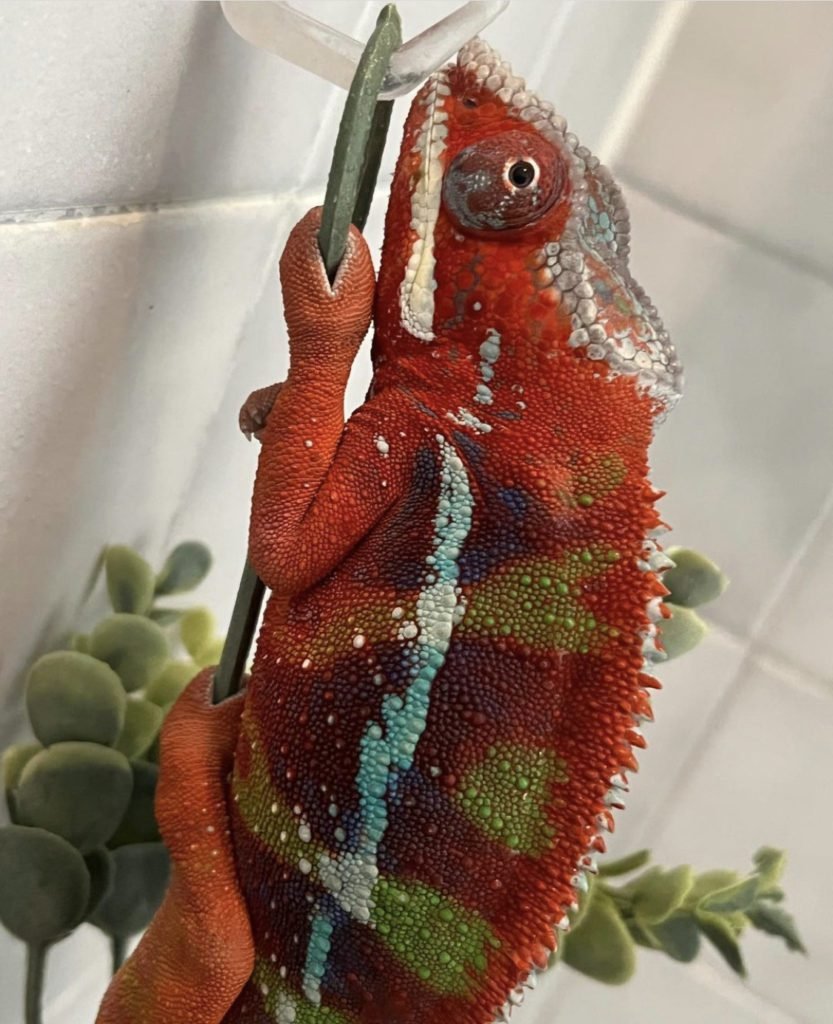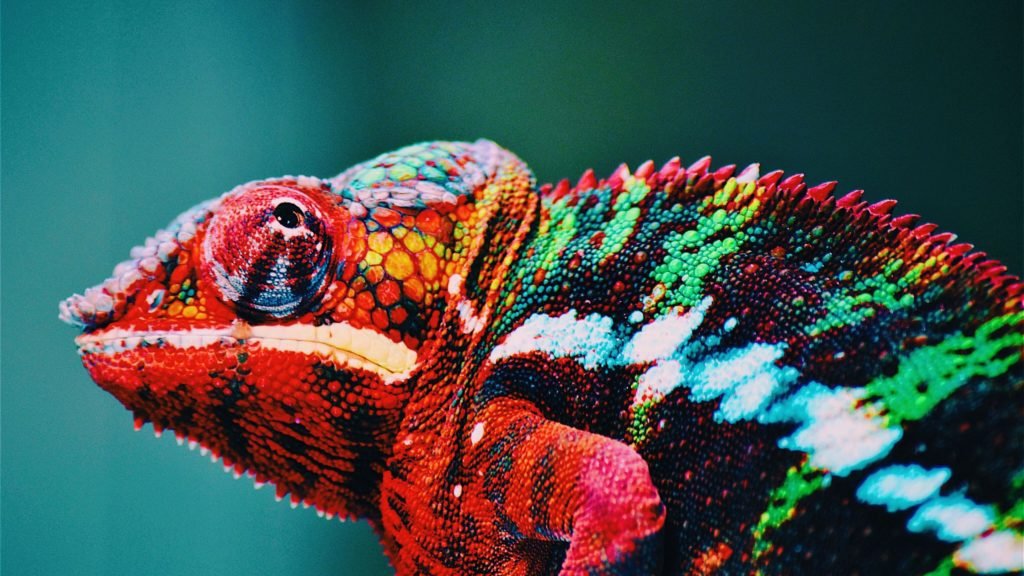The chameleon’s ability to change color is a unique and fascinating trait. This transformation is much more than just a simple cosmetic shift. It’s a complex physiological process that allows these creatures to blend into their surroundings, communicate with potential mates, and even regulate their body temperature.
The chameleon’s chromatophores and iridophores, located just below its skin, enable this fantastic skill. These cells contain pigments that can expand or contract depending on the chameleon’s physiological state and environment.
Example:
If a chameleon feels threatened or wants to scare off a rival, it will often turn a bold, bright color as a warning sign. If it wishes to blend in with its environment, it will shift to a more subdued color. This adaptive camouflage protects the chameleon from predators and helps it avoid being spotted by prey when hunting.
The chameleon’s color-changing ability is one of many exceptional traits that make it unique.

You may also interest: Veiled Chameleons: An Enchanted Journey Through Beauty and Care
Why do chameleons change color?: The Science Behind Color Change
Physical Characteristics of Chameleons are fascinating creatures known for their incredible color-changing ability. These creatures boast distinctive physical features, including prehensile tails, large sticky tongues, and, most notably, eyes capable of independent movement. However, their unique skin that can change color in seconds sets them apart from other reptiles.
Role of Melanin and Pigments in Color Change
The color change of chameleons is due to the presence of specialized cells in their skin called chromatophores. These chromatophores contain pigments such as melanin, which determines the animal’s natural color. When a chameleon experience changes in its environment, such as changes in temperature or light, the chromatophores adjust the amount of melanin they release, leading to a change in skin color.
Environmental Factors Affecting Color Change
Light, temperature, and the chameleon’s emotional state can all affect its ability to change color. For instance, when a chameleon feels threatened, it might change to a brighter color to warn potential predators. Similarly, when a chameleon is trying to regulate its body temperature, it may change to a darker color to absorb more heat or to a lighter color to reflect heat.
Biological Functions of Color Change
Chameleons are known for their spectacular color-shifting ability, but did you know that this capability serves more purposes than camouflage? These little creatures use color change as a tool to fulfill various biological functions, each with its unique purpose. Let’s delve into the fascinating world of chameleons and uncover the rainbow hiding in their skin.
Camouflage: Blending into the Background
Have you ever seen a chameleon change color to match its surroundings? This fantastic feat of mimicry is accomplished for one primary purpose: camouflage. When a chameleon wants to hide from predators or blend into its environment, it changes color to match the foliage, rocks, or bark it is resting on. That helps it avoid being seen by potential threats and stay safe. But is good to clarified chameleons doesn’t try to match all the backgrounds.
Thermoregulation: Regulating Body Temperature
Chameleons, like most reptiles, are ectothermic, meaning they can’t regulate their body temperature internally. Instead, they rely on upon the sun or other external heat sources to warm up and become active. The color change can play a crucial role in reflecting or absorbing light. By changing the color of their skin to lighter or darker tones, chameleons can control the amount of heat they drink and regulate their body temperature.

You may also interest: Discovering the Dapper World of Jackson Chameleons: Nature’s Radiant Reptiles
Why do chameleons change color? Expressing Emotions and Intentions
Chameleons are solitary creatures and don’t typically live in groups. However, the color change is vital in communication and social signaling when they contact each other. For example, when a male chameleon wants to attract a mate, it will show off its brightest, most vibrant colors. If it feels threatened by another male, it may change color to a dark, intimidating shade. Using color shift this way, chameleons can express their emotions and intentions without engaging in physical confrontations.
Examples of Color Change in the Wild: Unraveling the Aesthetic Alchemies of Chameleons
Chameleons are the pinnacle of animal chromatic changeability with their fantastic ability to change color and enchant the beholder. These enigmatic creatures with protuberant eyes, prehensile tails, and elastic tongues have a wonderful gift that has inspired countless minds throughout history. With their temporary transformations, chameleons have become synonymous with metamorphosis and the art of disguise.
Threat Displays: Fiery Flames of Intimidation
When attacked, a chameleon can become a bright yellow, orange, or red, sometimes with black or white patterns, to show its hostility. This dazzling, known as a threat display, is meant to intimidate the potential attacker and avoid physical conflict. The Parson’s and Flap-necked chameleons hiss or creak to express their anger.
Courtship and Mating Behavior: A Symphony of Colors
Chameleons may change color to attract a partner or express sexual arousal. An attractive female, the mating season, or environmental conditions like temperature or humidity might trigger this color shift. Some species, such as the Veiled chameleon or Jackson’s chameleon, have distinct courtship displays. That involves specific color changes and behavioral rituals, such as head bobs, body waving, or tongue flicking.
Territorial Behavior: The Art of Defending Your Domain
When confronting a rival, a chameleon may change color to express its authority and claim a region. Physical displays often accompany this territorial behavior. Such as head bobbing, body waving, or eye bulging, to establish a pecking order and avoid conflict. Fischer’s and Madagascar’s gigantic chameleons have different territorial marks. Such as spots or stripes to reinforce their message of territoriality.

You may also interest: Uncover the Unique World of Chameleon Diet: What to Feed Your Exotic Pet
FAQ about Why do chameleons change color?
Do Chameleons change color to match the background?
The answer is No.
Chameleons do not switch colors to match their background.
Does it mean they are angry if they are darker?
Dark colors mean:
-Chameleon is cold
-Chameleon is feeling threatened by a superior opponent (sometimes that is you)
What is the role of melanin in color change?
Melanin is a pigment that determines the color of the chameleon’s skin. By controlling the amount of melanin in its skin, a chameleon can change its color to match its environment and communicate with other chameleons.
Can chameleons change color instantly?
Yes, chameleons can change color instantly in just a matter of seconds.
What is the difference between the color change in male and female chameleons?
The color change patterns in male and female chameleons can differ in intensity and frequency. Males display more vibrant and intense color changes during social interactions, while females have a more subtle color change.
Do all species of chameleons change color?
Not all species of chameleons can change color. Some species have limited color change abilities, while others may not change color at all.
Can color change in chameleons be used to predict their mood?
The color change of chameleons can reflect their mood and social state. For example, a chameleon may change color in response to a perceived threat or when engaging in courtship behavior. Also, to absorb heat:
Dark= absorb more heat
light= Reflect heat

